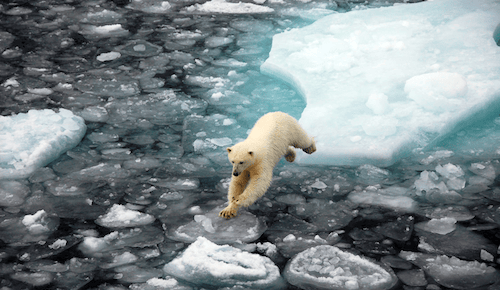
Scientists take ‘blue-action’ to help society cope with the impacts of dramatic Arctic climate changes
An international project dedicated to the Arctic and the Northern Hemisphere aimed at describing, modelling and predicting the weather and climate of these regions on seasonal to decadal time scales. It will help empower Arctic communities and businesses to make informed choices through better forecast systems. The CMCC Foundation is partner of the project and will be mainly involved in the characterization of weather and climate extreme events while providing analyses, coordinated experiments, deliverables and related scientific publications.
While the Arctic faces rapid warming and less sea ice currently covers the Arctic Ocean than ever before at this time of the year, an international partnership launches a major project to improve our detailed understanding of the processes and impacts of this changing climate and to construct better long-term forecast systems for the increasingly extreme weather of the Arctic and the wider northern hemisphere.
Blue-Action: Arctic Impact on Weather and Climate is a four-year research and innovation project funded by the European Union’s Horizon 2020 programme with €7.5 million investment. It brings together 116 experts from 40 organisations in 17 countries on three continents working in academia, local authorities and maritime industries.
Pooling their expertise, skills, approaches and networks, the partners aim to improve how we describe, model and predict the weather and climate on seasonal to decadal time scales in the Arctic and over the northern hemisphere. This information will allow communities and businesses in Eurasia and North America to develop and plan their activities better.
The CMCC Foundation will contribute in terms of analyses, coordinated experiments, deliverables and related scientific publications (WP1, WP3, WP4). In particular, the CMCC activities will be dedicated to the characterization and analysis, including predictive skill, of weather extremes (i.e. polar lows) in models and observations; the analysis of teleconnections (atmospheric and oceanic pathways) of Arctic sea-ice changes on Northern Hemisphere climate and extremes; the evaluation to improve predictive skill of Northern Hemisphere high-latitudes weather and climate; innovative numerical simulations aimed at better understanding the linkages between the Arctic sub-system and the climate of the lower latitude.
The CMCC is also involved in clustering research communities focusing on Blue Growth/Arctic impacts and defining best practices for the use of seasonal predictions (WP6).
“We will deliver this by synthesizing observations, assessing model performance, conducting coordinated multi-model sensitivity experiments, reducing and evaluating the uncertainty in prediction systems and developing new initialization techniques” explains Dr Daniela Matei from the Max-Planck Institute for Meteorology in Hamburg, one of two coordinators of the project.
“Working directly with local communities, businesses operating in the Arctic and industrial organisations, Blue-Action will demonstrate new opportunities for growth through tailored climate services. These will give users the information they need to live and work safely and successfully in the rapidly changing regions in and surrounding the Arctic” says project coordinator Dr Steffen M. Olsen from the Danish Meteorological Institute in Copenhagen.
“We are starting today to reach out to the many communities and businesses in the far north to work with us to guide our research direction and to co-develop adaptation mechanisms that will allow them to not only sustain but to boost their performance,” says Steffen Olsen.
“We will collaborate with other modelling and observational climate projects funded within the JPI-Climate Belmont-Forum, EU-H2020 frameworks to maximise the synergy and efficiency of our research efforts,” adds Dr Matei.
While the project began its work on 1st December 2016, the Blue-Action kick-off meeting will be held 18-20 January 2017 at the Max Planck Society’s Harnack-Haus in Berlin.
For more project details please visit the website: www.blue-action.eu
Current situation in the Arctic: both the global mean and the Arctic surface temperatures are at record high and the extent of sea ice covering the Arctic ocean has reached the lowest level ever recorded for this time of the year. The Washington Post published a pertinent summary of the extraordinary climate unfolding in the Arctic
About the project:
The Blue-Action consortium consists of 40 organisations from within the EU (Denmark, Finland, France, Germany, Italy, Netherlands, Portugal, Spain and UK) and other Arctic and maritime nations such as Canada and the USA, Russia, China and South Korea, and Norway, Iceland and the Faroe Islands.
Blue-Action contributes to the implementation of the Trans-Atlantic Ocean Research Alliance and the EU’s blue growth agenda and its long-term strategy to support sustainable growth in the marine and maritime sectors.
This project has received funding from the European Union’s Horizon 2020 research and innovation programme under grant agreement no 727852.



